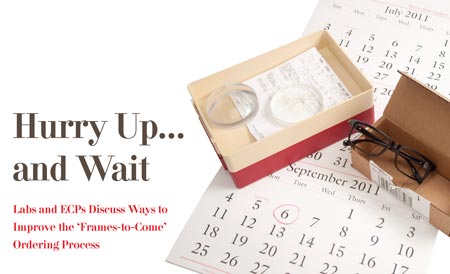 |
By Judith Lee
This article also appears in the September/October issue of LabTalk magazine.
In this digital age, online ordering and remote tracing are technologies of the time. But as high-tech as it all is, both optical laboratories and retailers are suggesting that a big dose of common sense and good, old-fashioned direct communication might be what’s needed to enable “frame-to-come” ordering and “no-frame-to come” to be viable options.
First, it bears noting that wholesale and retail sides agreed that online ordering is a good thing.
“We want to have more online ordering, not less,” noted Mike Fussell, director of customer service for Robertson Optical, an Atlanta-based wholesale lab. “We use computer software that won’t allow the retailer to leave data off.”
“Online ordering is an overall improvement; it’s much better than writing up the order on a carbon copy and sending that out,” said Ben Kahn of Berryessa Optometry, San Jose, Calif., who remembers that’s how it was done 14 years ago when he became an optician.
At this point, agreement doesn’t disappear, but it takes separate routes.
Optical labs complain that retailers often don’t provide complete data, and technology can’t always fill the void. Those in the retail “trenches” observe that labs don’t have to face impatient customers who don’t want to hear about a delayed turnaround, and are even less interested in hearing who is at fault.
Data In, Eyewear Out
Like so many computer-aided processes, the quality of the data determines the quality of the outcome.
“Today, if you let the retailers fax in their orders, they will leave off critical information,” Fussell said. “A lot of the problems labs have today are unknowingly caused by retailers.”
He noted that time-pressured retailers may be forgetting their basics: seg height, frame height, pd: “We ask for vertical measurement, they don’t have it. The lab cannot calculate a job properly without all the measurements. Sometimes they don’t have the name of the frame to pull out the shape.”
An important technology resource is Tracing Points from Frames Data, which also publishes LabTalk magazine. This database of frame information and trace files enables optical laboratories to select the correct lens blank and begin surfacing before the frame arrives, reducing turnaround by a day or so.
“Tracing Points definitely helps. When an online order comes in, we can get correct geometry from Tracing Points and have it right 99 percent of time,” said John Sutherlin, a partner in Sutherlin Optical, a wholesale lab based in Kansas City, Mo. “If you let the computer guess, thickness or optical placement will be wrong, you can order the wrong lens and then what do you do with those lenses?”
Robertson Optical uses Tracing Points, too, and finds its data complete for certain frame brands, but not for all brands.
“Sometimes, I find the name of the frame and the data, but no shape with it. It’s probably a work in progress with Frames Data—I’m not sure manufacturers are supplying all the data that’s needed,” Fussell said.
That’s exactly the case, said Tom Lamond, president of Frames Data: “We encourage frame companies to provide a frame sample and pattern for our technicians to trace, but there can be a lag time before the frame is available. Tracing Points never will be 100 percent complete, but the vast majority of frames in our database have a trace file available.”
He noted that, while not every frame company participates in Frames Data, knowing they will be included in Tracing Points often helps convince them. A new feature on www.framesdata.com allows labs to request Tracing Points data from specific manufacturers. As a result of lab requests, several high-end manufacturers have started to participate in Frames Data/Tracing Points.
About a third of wholesale labs, many of them the larger labs with sizeable customer bases, subscribe to Tracing Points. A subscription provides the user with monthly or quarterly updates.Fussell noted that Tracing Points definitely is the answer when a customer calls and asks, “Can you make this without the frame?”
Data can be a challenge for retailers, too. Order entry software may not be updated often enough, and some options are not on the drop-down list. The retailer then has to type the spec in manually or add a note, which takes more time and inserts the element of human error.
“Some labs are really good about reading our notes, others don’t get it. If I have to call the lab and explain it, I don’t have time for it,” said Evelyn Bader, optician For Primary Eye Care Associates, Chicago, Ill.
Kahn blames frame manufacturers for a certain amount of confusion: “I wish they would quit changing the names on their products every six months to a year, as it causes a lot of confusion. We are not kept informed about this.”
Communication Is Key
Communication is the key from the retailer’s point of view.
“I wish labs could tell us what range we can get on a specific lens, what AR we can and cannot use. Things change quickly, and it’s hard to keep up,” Bader said.
Retailers say they could get out ahead of customer annoyance if labs would be more proactive when there is a problem.
“The labs do not communicate well to us when there is breakage. They usually don’t tell us. We have to call them when the order doesn’t arrive. If they would communicate with us, we can tell the patient and then they are not as upset with us,” said Byl Urso, optical manager for Chang Eye Group, Pittsburgh, Pa.
Timing is everything, said optician Troy Kish of Cool Springs Eyewear, Franklin, Tenn. “The lab calls us on the ninth day to say they had breakage. It would help if they could expedite it the second time around, but now they just take another 10 days.”
The frame-to-come system can go awry in other ways. Urso said Davis Vision lost a box of frames from the Chang Eye shop, and a patient’s own frame was inside.
“In a case like this, we tell the patient we are not responsible if the lab loses or breaks the frame. Still, you are not going to have a happy patient when you tell them the frame is lost,” Urso noted.
Communication is a two-way street, optical labs say. “When it’s a wrap frame, which is not in the data base, tell us it’s a wrap frame. Also, please check the frame to make sure you entered the correct eyesize and bridge size, which are the most costly mistakes for us,” said Sutherlin.
No Frame to Come
 |
“In order to process a lenses-only order, we require a circumference of the lens as well as the frame type such as rimless groove, rimless drill, zyl, or metal,” said Corrine Hood, president of Katz and Klein, a Sacramento, Calif.-based wholesale lab. “We would like to see an electronic or faxed tracing as well. We see the idea of remote tracing as a big timing advantage to the patient, however since the choice of frames is so varied; it can make mounting lenses difficult under the best of circumstances. We do prefer to mount the lenses ourselves rather than sending out lenses only.”
The folks at Toledo Optical agree. “While we always prefer to have a frame on hand, when the patient needs to keep their frame and a customer wants to send in a remote trace…we certainly accept this, however we absolutely require a c-size,” said Jeff Szymanski, vice president, Toledo Optical, a wholesale lab in Toledo, Ohio.
To deal with this issue, Toledo Optical has found even greater success—over and above remote tracing—by building an exclusive frame shape database.
“In working with DVI daily, and on virtually every Rx we fabricate, we have assembled over 60,000 ‘cleaned up’ shapes, which more times than not, is exceedingly more accurate than a remote trace,” said Szymanski. “The biggest problem with remote tracers is that like any sophisticated measurement device, they require routine calibration, and while we as an industry placed tracers trying to create consistency—we almost created more chaos, due to the lack of proper calibration performed at the ECP level.”
It was just this issue that caused Toledo Optical to get away from remote tracing and build their own proprietary database, educating their customers on this new and improved method for dealing with no-frame-to-come.
Wish list
At the top of optical labs’ “wish list” are improvements in remote tracing.
“When we get tracings from 50 customers, we get 50 kinds of quality. There are different types of tracers, they may or may not be calibrated, and the stylist might distort the frame, especially the soft plastic ones,” Fussell said.
He urges retailers to invest in higher quality tracers, learn to calibrate them and use them with more precision.
Sutherlin said he prefers frame-to-come orders rather than remote tracing. “Very few of our customers use remote tracing, some have tried and stopped using it. With frame to come, we make the lenses fit the frame better. Tracing Points help us move the order forward when we receive it.”
Retailers are looking for more services that can be completed online.
“I would like to order warranties or remakes online. Now we have to call these in, you have to walk away from the patient and they are already unhappy, and it takes 15 to 20 minutes,” said Urso.
If the lab requires that problem orders be called in, please answer the phone, said Kish. “I always like a lab where a person answers the phone. When we have a difficult problem, we don’t like to listen to the recorded message that sends us to the website—but we can’t use the website.”
Kahn, who formerly worked in an optical lab, is sympathetic to the challenges labs face, but asks everyone to remember the end user. “The industry is driven by the person who receives that eyewear. Let’s not break it, and let’s make them happy.” ■
[email protected]











